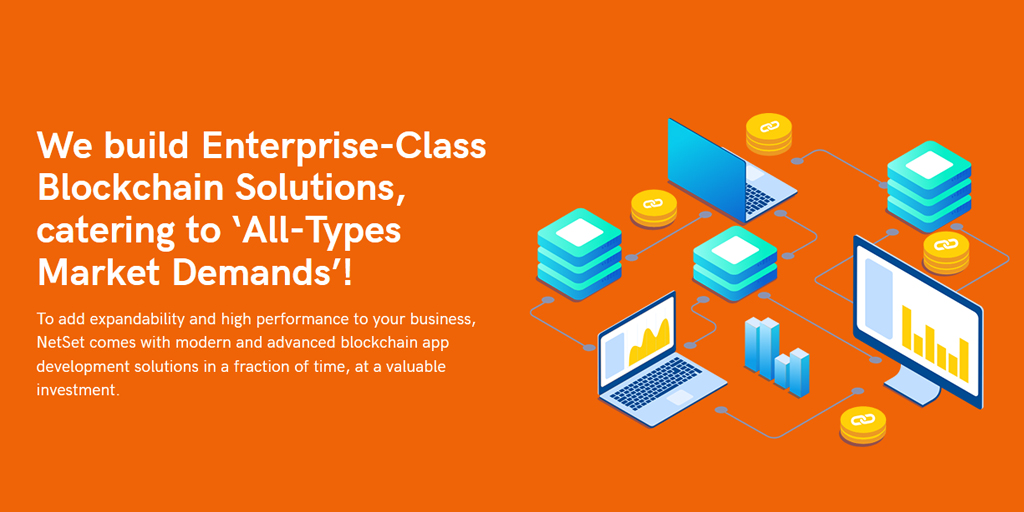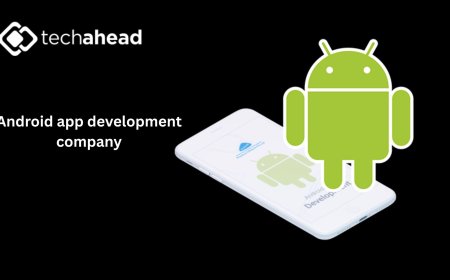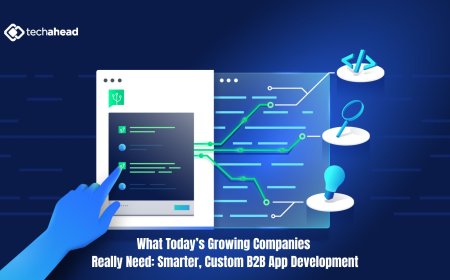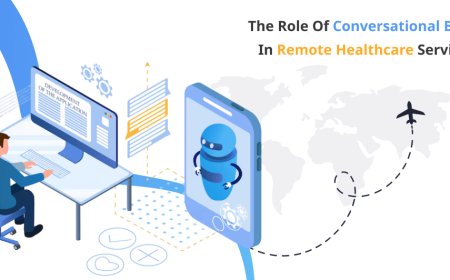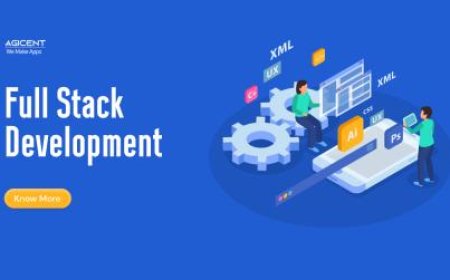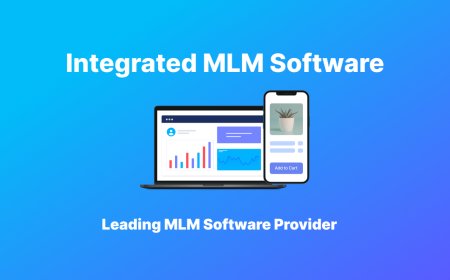Hire a Mobile App Developer: What to Know Before You Start
In today’s mobile-driven world, having a strong mobile app can be the difference between scaling your business and staying in the shadows. Whether you're a startup founder, a small business owner, or an enterprise executive, hiring the right mobile app developer is one of the most critical steps in turning your vision into a downloadable reality.

Introduction
In todays mobile-driven world, having a strong mobile app can be the difference between scaling your business and staying in the shadows. Whether you're a startup founder, a small business owner, or an enterprise executive, hiring the right mobile app developer is one of the most critical steps in turning your vision into a downloadable reality.
Think about ityour mobile app isnt just a tool. Its a digital representation of your brand. Its often the first touchpoint users have with your product or service. So, it better be intuitive, high-performing, and, most importantly, reliable.
But with so many optionsfreelancers, agencies, in-house developershow do you know who to hire? What should you consider before jumping into the hiring process? This guide dives deep into everything you need to know before you bring a mobile app developer on board.
Defining Your App Vision
Before you even start browsing developer profiles or sending out RFPs, you need to get crystal clear on your app vision. Why? Because a well-defined vision acts like a GPS for your development journey. Without it, youre just throwing darts in the dark.
Clarify Your App Idea and Goals
Start by asking yourself:
- What problem does my app solve?
- What makes it different from other apps in the market?
- What are my short-term and long-term goals?
Whether its an e-commerce app, a fitness tracker, or a social networking platform, having clear goals helps you communicate your expectations better to potential developers.
Identify Your Target Audience
Your apps features, design, and functionality should all be shaped by who will use it. Are you targeting tech-savvy Gen Z users? Busy parents? Corporate teams? Knowing your audience helps determine the user interface (UI), user experience (UX), and even technical choices like platform compatibility.
Understand Your Apps Core Features
Create a list of must-have features vs. nice-to-have features. For example:
- Login/signup
- Push notifications
- Payment integration
- GPS tracking
- Social sharing
This feature list becomes a part of your project brief and helps developers estimate time, cost, and complexity more accurately.
Bottom line: The more clarity you have at this stage, the smoother the hiring process and development phases will be.
Native vs Hybrid vs Cross-Platform
Now that your app idea is solid, its time to figure out how you want it built. There are three primary development approaches to consider: native, hybrid, and cross-platform. Each has its advantages and trade-offs.
Whats the Difference?
- Native apps are built specifically for a single platformiOS (using Swift/Objective-C) or Android (using Kotlin/Java).
- Hybrid apps use web technologies (like HTML, CSS, and JavaScript) wrapped in a native container. Think of them as websites that run like apps.
- Cross-platform apps use frameworks like Flutter or React Native to build one codebase that runs on both Android and iOS.
Pros and Cons of Each Development Approach
ApproachProsCons
Native High performance, better UX, full API access Higher cost, longer development time
Hybrid: Cost-effective, quick to build. Slower performance, limited native access
Cross-platform , one codebase, faster to deploy, not ideal for complex features
Choosing the Right Platform for Your App
Heres how to decide:
- If performance and user experience are top priorities (e.g., games, high-end apps), go native.
- If you're building a basic MVP to test the market, cross-platform or hybrid might be enough.
- For apps targeting both iOS and Android users on a tight budget, cross-platform development is often the best compromise.
Choosing the wrong platform can lead to wasted time and budget, so its worth getting advice from technical experts if youre unsure.
Types of Mobile App Developers
Youve got the idea. You know the tech. Now comes the million-dollar questionwhos going to build it?
Freelancers
Freelancers are independent developers who work solo. Theyre often affordable and flexible, making them ideal for startups or small projects. But they come with risksmissed deadlines, limited scalability, and inconsistent quality.
Pros:
- Lower cost
- Direct communication
- Fast turnaround
Cons:
- Limited availability
- Single point of failure
- Hard to scale
In-House Developers
Hiring a full-time developer to work within your team gives you complete control over the development process. Its perfect for long-term projects, but expensive and time-consuming to set up.
Pros:
- Full control
- Seamless collaboration
- Deep brand understanding
Cons:
- High salary and overhead costs
- Limited skill diversity unless you hire a team
Agencies
Agencies offer a team of professionalsdevelopers, designers, project managers, and testers. Theyre great for large or complex projects and can scale quickly. But they come at a premium price.
Pros:
- Access to a complete team
- Structured workflow
- Post-launch support
Cons:
- Higher cost
- Less flexibility
- Formal communication process
Choosing between these options depends on your project size, timeline, and budget.
Budget Planning
Lets talk moneybecause mobile app development isnt cheap, and surprises in the budget can derail your entire project.
Cost Breakdown of Mobile App Development
Heres a rough estimate based on complexity:
App TypeEstimated Cost
Simple App (MVP) $5,000 $25,000
Moderate Complexity $25,000 $75,000
High-End/Enterprise $75,000 $250,000+
Factors That Influence Pricing
- Developers location and experience
- Chosen platform (iOS, Android, or both)
- Feature set (simple login vs. AI integration)
- Design complexity
- Backend/server requirements
Tips to Stay Within Budget
- Start with an MVP
- Use open-source tools and frameworks
- Set clear milestones
- Avoid feature creep
- Use cross-platform solutions for wider reach with less cost
Budget planning isnt just about finding the cheapest optionits about investing wisely to avoid costly mistakes later.
Where to Find Mobile App Developers
So, youve defined your project, set your budget, and chosen a development approachnow its time to find the right talent. But where do you look?
Best Platforms to Hire Freelancers and Agencies
Here are some popular and reliable platforms to hire developers:
- Freelancer Platforms
- Upwork Great for vetted freelancers and agencies with reviews.
- Toptal Top 3% of freelance talent, but at premium rates.
- Fiverr Pro Best for small tasks or MVP features.
- Guru Flexible pricing and payment terms.
- Agency/Company Directories
- Clutch.co Verified reviews of development agencies.
- GoodFirms Similar to Clutch but broader in scope.
- DesignRush Helps find development firms based on industry and size.
- Job Boards and Communities
- Stack Overflow Jobs
- AngelList Talent Especially good for startups.
- LinkedIn Great for both freelancers and agencies with strong networks.
Red Flags to Watch Out For
Not all that glitters is gold. Keep an eye out for:
- Too-good-to-be-true pricing
- Lack of portfolio or real-world examples
- Poor communication or slow response times
- No clear process or timeline
- Unclear ownership of code or intellectual property
The Role of Referrals and Reviews
Word of mouth still rules. Ask colleagues, friends, or LinkedIn connections whom theyve worked with. Reviews on platforms like Clutch and Upwork offer insights into real experiences, timelines, and professionalism.
Pro tip: Reach out to a developers past clients directly. Youd be surprised how much people are willing to share when you just ask.
Evaluating Developer Portfolios
A resume might tell you what someone can do, but a portfolio shows what theyve done. This is your best window into a developers skill level, creativity, and problem-solving abilities.
What to Look For in Past Projects
- Design & UX: Is the interface clean, intuitive, and modern?
- Functionality: Does the app perform as expected?
- Consistency: Are there signs of quality across multiple projects?
A solid portfolio should include:
- Screenshots or live app links
- A brief description of the apps purpose
- Features the developer personally worked on
- Technologies used
Industry Relevance and Case Studies
Has the developer worked on apps in your industry? If youre building a fitness app, someone whos already built similar platforms understands the audience and potential challenges.
Also, request case studies if available. These often highlight:
- Business goals
- The development process
- Roadblocks and how they were overcome
- Results or app performance post-launch
Questions to Ask Based on Portfolio Work
- What was your specific role in this project?
- What challenges did you face, and how did you solve them?
- Is the app still live? If not, why?
- How long did the project take?
- Did you handle post-launch updates?
A thoughtful, transparent developer will be happy to walk you through their previous work, and youll learn more from that conversation than any resume.
The Interview Process
Hiring isnt just about skillsits about communication, problem-solving, and chemistry. Once youve shortlisted candidates, its time to interview.
Technical and Non-Technical Questions to Ask
Heres a mix of questions to test both hard and soft skills:
Technical Questions:
- What programming languages and frameworks do you specialize in?
- Can you describe your development process?
- How do you handle security and data protection?
- Have you worked with third-party APIs or payment systems?
- What tools do you use for testing and deployment?
Non-Technical Questions:
- How do you handle feedback and revisions?
- What happens if you're delayed or run into challenges?
- How do you prioritize tasks when juggling multiple projects?
- Can you walk me through a time you made a tough project decision?
Assessing Communication and Problem-Solving Skills
Pay close attention to how clearly and confidently a developer explains things. Are they giving vague answers or backing up statements with real-world examples?
Problem-solving is key in development. Give them a hypothetical challenge like:
"Youre behind schedule, and a core feature isn't working. What do you do?"
Their answer will tell you a lot about how they manage pressure and expectations.
Importance of Cultural Fit and Time Zone Alignment
Even if the work is remote, your developer is still part of your team. Do their values align with yours? Will time zone differences affect deadlines or meetings?
Try scheduling a quick video call to test language fluency, work ethic, and responsiveness. A 15-minute conversation can save you weeks of miscommunication down the road.
Understanding Contracts and Agreements
Once youve found the right developer or agency, dont just shake handsput it in writing. A clear contract protects everyone involved and sets expectations upfront.
NDAs, IP Rights, and Ownership
- Non-Disclosure Agreements (NDAs) ensure your app idea stays confidential.
- Intellectual Property (IP) clauses should clearly state that YOU own the app code, designs, and assetsnot the developer.
- Make sure to get access to source code and repositories (like GitHub) as work progresses.
Milestones and Payment Terms
Break the project into stageslike design, development, testingand assign payment milestones. This:
- Reduces risk
- Motivates progress
- Gives you checkpoints to review the work
Avoid paying the full amount upfront. A common structure is:
- 30% upfront
- 40% after halfway
- 30% upon completion
Support and Maintenance Clauses
Add a section about post-launch support. This can include:
- Bug fixes for X days/months after launch
- Optional maintenance packages
- Feature updates
A great developer wont just build your apptheyll stick around to help it grow.
Project Management and Communication Tools
Hiring the best developer in the world wont help if your communication breaks down mid-project. Thats why using the right project management and communication tools is crucial to keeping everything on track.
Tools for Effective Collaboration
Here are some tried-and-true tools that help remote teams stay aligned:
- Trello or Jira For task and sprint management. Helps you visualize progress and assign responsibilities.
- Slack For real-time messaging, file sharing, and quick check-ins.
- Zoom or Google Meet For weekly calls, demos, and sprint reviews.
- Figma or Adobe XD For collaborating on design and UX.
- GitHub or Bitbucket For code sharing, version control, and code reviews.
A skilled developer or agency will likely recommend a tool stack theyre comfortable with, but make sure it fits your workflow too.
Setting Expectations Early
The most successful projects are those where everyone is on the same page from day one. Set clear expectations for:
- Working hours and time zones
- Meeting schedules
- Response times
- Communication channels
- Project documentation
Establish a rhythm early, and stick to it. Weekly standups or bi-weekly sprint reviews can help you keep your finger on the pulse of the project.
How to Monitor Progress Remotely
You dont need to micromanagebut you do need visibility.
Heres how to monitor progress without being overbearing:
- Use project boards (like Trello or Asana) to see task status
- Ask for weekly reports or summaries
- Request demo builds or test links at the end of each sprint
- Use GitHub commits and pull requests to track coding activity
Trust is key, but trust also comes from transparency and accountability.
Quality Assurance and Testing
Youve hired the developer, youre checking the boxes, and the app is coming togetherbut how do you make sure it works?
Thats where Quality Assurance (QA) comes in.
Importance of QA in App Development
Think of QA like a stress test for your app. It ensures that your app:
- Works as expected
- Doesnt crash
- Handles user input properly
- It is secure and fast
Skipping this step is like launching a rocket without checking the engineit might fly, but it might explode too.
Testing Types: Manual, Automated, Beta Testing
There are several layers of QA youll want to consider:
- Manual Testing A QA tester physically interacts with the app to check features, navigation, bugs, etc.
- Automated Testing Scripts that run pre-set test scenarios automatically, saving time for repetitive testing tasks.
- Beta Testing Releasing the app to a small group of real users to collect feedback and uncover bugs before full launch.
For most apps, a mix of all three works best. If your developer or agency skips testing, thats a red flag.
Ensuring Device Compatibility
One of the biggest challenges in mobile development is making sure your app works across:
- Different screen sizes
- Multiple OS versions (e.g., Android 10 vs. Android 13)
- Different devices (iPhones, Samsung, tablets, etc.)
Ask your developer how they plan to test across devices and operating systems. Emulators are good, but real-device testing is better.
Launching Your Mobile App
Youve built the app, tested it, and youre ready to go livebut launching isnt just about clicking "publish." Its about doing it right.
Pre-Launch Checklist
Before you hit that launch button, make sure:
- All bugs and crashes are resolved
- App performance is smooth and fast
- Security features are implemented (e.g., HTTPS, secure logins)
- App Store screenshots and descriptions are polished
- Analytics tools (like Firebase or Mixpanel) are integrated
Run final UAT (User Acceptance Testing) to ensure the app meets all your business needs.
App Store and Google Play Submission
Each platform has its submission process:
- iOS (App Store):
- Requires an Apple Developer account ($99/year)
- Manual review process that takes 13 days
- Android (Google Play):
- Requires Google Play Console account ($25 one-time fee)
- Faster approval (often same-day)
Your developer should handle the submission and ensure the app meets all guidelines.
Marketing and User Feedback Strategies
An app without users is just code. Heres how to get traction:
- Create a landing page or website
- Promote through social media and email lists
- Use influencer partnerships or PR outreach
- Encourage users to leave reviews and feedback
- Run ads targeting your niche audience
Early feedback is goldit helps you plan future updates and fixes.
Post-Launch Maintenance and Updates
Your app is live, but your job isnt done. Mobile apps require continuous care to stay functional, secure, and competitive.
Bug Fixing and Performance Optimization
No app is perfect on launch. Expect some bugs and minor issues. Your developer should be on standby to:
- Patch crashes
- Improve loading times
- Fix UI glitches
Ask for a support windowmost developers offer 13 months of post-launch bug fixes for free or at a discounted rate.
Feature Upgrades Based on User Feedback
Listen to your users. Youll quickly find out what features they loveand whats missing.
Plan feature updates in sprints. Keep them small, focused, and regular. A good update schedule keeps users engaged and reduces churn.
Long-Term Developer Support
Youll need ongoing help with:
- OS updates (e.g., iOS 18 or Android 15 changes)
- Security patches
- Backend updates
- Scaling infrastructure
If you used a freelancer, make sure theyre available long-term, or have someone else ready to take over. If you hired an agency, consider a long-term support retainer.
Common Mistakes to Avoid
Here are the most common pitfalls youll want to sidestep:
1. Skipping Research and Planning
Diving straight into development without a clear roadmap leads to scope creep, missed deadlines, and blown budgets. Always start with a solid plan.
2. Hiring Based on Price Alone
Cheap can get expensive. A low-rate developer might end up costing more in delays, bugs, and rewrites. Focus on value, not just cost.
3. Ignoring Legal Agreements
Always sign contracts, NDAs, and IP transfer agreements. Verbal promises wont hold up in court if things go south.
4. Poor Communication
Misaligned expectations, unclear feedback, and delayed responses are a recipe for disaster. Communicate consistently and clearly.
5. Neglecting Testing and QA
Skipping testing is like skipping seatbelts. It might be fineuntil it isnt. Never launch without a solid QA process.
Conclusion
Hiring a mobile app developer isn't just a transactionits a partnership that shapes your product, your brand, and potentially your future business success.
Start with a clear vision, choose your development path wisely, and take your time vetting developers. Whether you go with a freelancer, an in-house hire, or an agency, focus on quality, communication, and long-term support.
The mobile app world is competitivebut with the right team by your side, you wont just surviveyoull thrive.
FAQs
1. How long does it take to build a mobile app?
Simple apps can take 23 months, while complex apps with advanced features may take 612 months or more.
2. Whats the average cost to hire a mobile app developer?
Freelancers may charge between $25$150/hr, while agencies can charge $10,000$200,000+ per project, depending on scope and complexity.
3. Should I build for iOS or Android first?
It depends on your audience. If you're targeting the U.S. or high-income users, start with iOS. For global reach, consider Android or go cross-platform.
4. Do I need to hire a separate designer and developer?
Some developers handle both, but for best results, hire a dedicated designer to focus on UI/UX while the developer handles coding.
5. Can I update my app after launch?
Absolutely. Regular updates improve performance, fix bugs, and keep users engaged. Many apps release monthly or quarterly updates.








